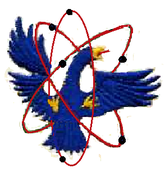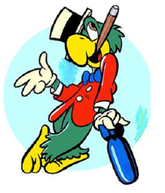| This article includes a list of general references, but it lacks sufficient corresponding inline citations. Please help to improve this article by introducing more precise citations. (December 2012) (Learn how and when to remove this message) |
| 387th Tactical Fighter Squadron | |
|---|---|
 F-100D Super Sabre as flown by the squadron F-100D Super Sabre as flown by the squadron | |
| Active | 1942–1946; 1947–1949; 1954–1959 |
| Country | |
| Branch | |
| Role | bombardment, fighter-bomber |
| Nickname(s) | Screaming Hawks (1955-1959) |
| Engagements | Southwest Pacific Theater |
| Decorations | Presidential Unit Citation Philippine Presidential Unit Citation |
| Insignia | |
| 387 Fighter-Bomber Sq emblem |  |
| 387 Bombardment Sq emblem |  |
The 387th Tactical Fighter Squadron is an inactive United States Air Force unit. Its last assignment was with the 312th Tactical Fighter Wing at Cannon Air Force Base, New Mexico, where it was inactivated on 18 February 1959.
History
World War II
Established in early 1942 as a light bomber squadron, equipped with Douglas A-24 Banshees, although equipped with export model Vultee A-31 Vengeance dive bombers for training. Trained under Third Air Force in the southeast United States, also used for antisubmarine patrols over the Atlantic southeast coast and then Gulf of Mexico.
Deployed to Southern California in early 1943 to the Desert Warfare Center, trained in light bombing while supporting Army maneuvers in the Mojave Desert until October.
Re-equipped with North American A-36 Apache dive bombers and deployed to New Guinea as part of Fifth Air Force. In the Southwest Pacific the squadron attacked Japanese strong points and tactical positions and targets of opportunity in support of General Douglas MacArthur's campaign along the north coast of New Guinea; then advancing into the Netherlands East Indies and Philippines as part of the island hopping campaign. Re-equipped with Curtiss P-40 Warhawks; then later Douglas A-20 Havocs. Engaged in heavy fighting on Leyte; Mindoro and Luzon in the Philippines during 1944–1945.
The squadron moved to Okinawa in mid-August and after the atomic bomb missions had been flown; remained on Okinawa until December until returning to the United States with most personnel demobilizing. It was inactivated as a paper unit on 6 January 1946.
Reserve operations
The squadron was reactivated as a B-29 Superfortress unit in the reserves in 1947, but lack of funding and personnel led to rapid inactivation.
Cold War fighter operations
Transferred to Tactical Air Command in the mid-1950s and activated first with North American F-86 Sabres, then North American F-100 Super Sabres in 1958. Inactivated in 1959 when its parent 312th Tactical Fighter Wing was inactivated and its personnel and equipment transferred to the 27th Tactical Fighter Wing. Squadron personnel and equipment of the squadron were transferred to the 523d Tactical Fighter Squadron.
Lineage
- Constituted as the 387th Bombardment Squadron (Light) on 28 January 1942
- Activated on 15 March 1942
- Redesignated 387th Bombardment Squadron (Dive) on 27 July 1942
- Redesignated 387th Bombardment Squadron, Light on 6 December 1943
- Redesignated 387th Bombardment Squadron, Heavy on 19 July 1945
- Inactivated on 18 December 1945
- Redesignated 387th Bombardment Squadron, Very Heavy on 14 July 1947
- Activated in the reserve on 30 July 1947
- Inactivated on 27 June 1949
- Redesignated 387th Fighter-Bomber Squadron on 29 July 1954
- Activated on 1 October 1954
- Redesignated 387th Tactical Fighter Squadron on 1 July 1958
- Inactivated on 18 February 1959
Assignments
- 312th Bombardment Group, 15 March 1942 – 18 December 1945
- Tenth Air Force, 30 July 1947
- 312th Bombardment Group, 13 August 1947 – 27 June 1949
- 312th Fighter-Bomber Group, October 1954
- 312th Fighter-Bomber Wing (later 312th Tactical Fighter Wing), 8 October 1957 – 18 February 1959
Stations
|
|
Aircraft
- Vultee A-31 Vengeance, 1942–1943
- Douglas A-24 Banshee, 1942–1943
- North American A-36 Apache, 1943
- Curtiss P-40 Warhawk, 1943–1944
- Douglas A-20 Havoc, 1944–1945
- North American F-86 Sabre, 1955–1956
- North American F-100 Super Sabre, 1956–1959
References
Notes
- Explanatory notes
- Aircraft is North American F-100D-85-NH Super Sabre, serial 56-3460. Assigned to the 523d Tactical Fighter Squadron at time of photo.
- Approved 5 December 1955.
- Approved 27 October 1943.
- Citations
Bibliography
![]() This article incorporates public domain material from the Air Force Historical Research Agency
This article incorporates public domain material from the Air Force Historical Research Agency
- Maurer, Maurer, ed. (1983) . Air Force Combat Units of World War II (PDF) (reprint ed.). Washington, DC: Office of Air Force History. ISBN 0-912799-02-1. LCCN 61060979. Retrieved 17 December 2016.
- Maurer, Maurer, ed. (1982) . Combat Squadrons of the Air Force, World War II (PDF) (reprint ed.). Washington, DC: Office of Air Force History. ISBN 0-405-12194-6. LCCN 70605402. OCLC 72556. Retrieved 17 December 2016.
- Ravenstein, Charles A. (1984). Air Force Combat Wings, Lineage & Honors Histories 1947-1977 (PDF). Washington, DC: Office of Air Force History. ISBN 0-912799-12-9. Retrieved 17 December 2016.
- Watkins, Robert A. (2013). Insignia and Aircraft Markings of the U.S. Army Air Force In World War II. Vol. V, Pacific Theater of Operations. Atglen,PA: Shiffer Publishing, Ltd. ISBN 978-0-7643-4346-9.
| Air Forces |  | ||||||
|---|---|---|---|---|---|---|---|
| Air Divisions | |||||||
| Named units | |||||||
| Wings |
| ||||||
| Former bases |
| ||||||
| Aircraft |
| ||||||
| Previously: Philippine Department Air Force (1941); Far East Air Force (1941-1942) | |||||||||||||||||||||||||||||
| Airfields |
|  | |||||||||||||||||||||||||||
| Units |
| ||||||||||||||||||||||||||||
| |||||||||||||||||||||||||||||